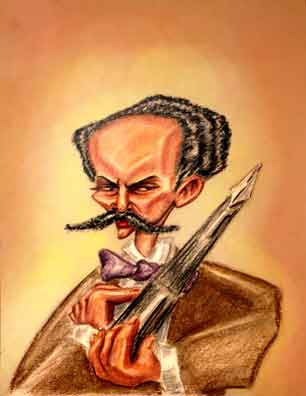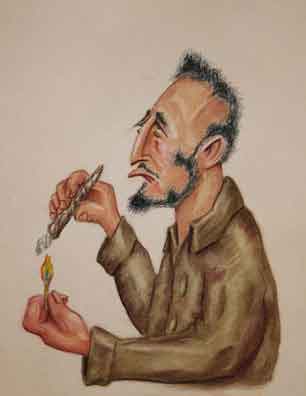José Martí
Everyone's Revolutionary

José Martí
Everybody's Revolutionary
José Martí, like George Washington. is the type of revolutionary everyone loves. After all, everyone is - or at least says they are - for equal rights, against oppression, and support freedom. José believed in all those things.
By 1600, virtually all of South, Central, and a good chunk of North America were claimed by Spain (Brazil, of course, belonged to Portugal). But by the early 1830's Spain only held onto Cuba and Puerto Rico. Also for a long time the US had been looking on Spain as an unwelcome interloper in the Western Hemisphere even though they had been in there longer than any other European nation. ¡Los Estados Unidos, Si! ¡España, No!
Then in 1868, a rich sugar planter named Carlos Manuel de Cespedes decided, as did George and his friends, that if they waited for the mother country to give you independence, they'd hardly be able to fit all their wheelchairs around the desk at the signing ceremony. So Carlos and his fellow revolutionaries declared Cuba independent and freed their slaves. Of course, Spain sent the troops in to give the upstarts a sound thrashing.
Well, after ten years, everything was in a stalemate. So Spain and the rebels arranged a cease fire. Cuba would still belong to Spain, and slavery was still legal. As a consolation prize, all slaves who fought with Carlos would be freed, and Carlos and his friends would not be arrested and could go back to their homes and haciendas.
José, though, had not fared too well. He had been born in Havana in 1853 and when José was still young, his mom and dad had returned briefly to Spain where they were born. However, they soon moved back to Cuba where José was raised in a liberal environment. Naturally he was sympathetic with Carlos when the war broke out.
In 1869, only age 16, José founded a newspaper which supported Carlos. Possibly because José was so young the Spanish authorities left him alone until they found what they considered a treasonous note written to a friend. They arrested José, and although he was sentenced to six years in prison, he was released after six months. But because he was held in shackles, his legs had been badly injured, and he had to walk with a cane the rest of his life.
José's release was conditional with the understanding that he would return to Spain to be re-educated. He enrolled at universities in Madrid and Zarazoga, studying subjects needed to bolster his chosen career as a writer. In 1875, he went to Mexico where he married Carmen Zayas-Bazan on December 20, 1877. But his sentiments didn't change, and he returned to Cuba the next year. Following a brief flurry of fighting the next year (which Jose did not join), he was (again) exiled to Spain. But after he landed on the Iberian peninsula, he managed to sneak over to France, where he boarded a ship bound for the United States. He arrived in New York on January 3, 1880. His wife Carmen and infant son had remained in Havana and only visited Jose a few times during the rest of his lifetime.
It was in New York that José really became known as a writer and speaker where he continued to advocate racial equality, fundamental human rights, and Cuban independence. Although he wasn't as fluent in English as in Spanish, he wrote articles and gave speeches in both languages. He particularly liked writing about North American culture for the Hispanic readers, and he was particularly fascinated and intrigued by the social significance of Coney Island where all classes could democratically mix and yet remain somehow separated based on their wealth.
Jose's writings are well worth reading (even in English translation) but today few English speakers even know of him. About the closest he came to widespread recognition was in 1966 when the soft rock group (as the genre was called) the Sandpipers released their version of Guantanamera. But even then few were aware that the words were taken from José's Versos Sencillos (Simple Verses). But at least Pete Seeger, who frequently performed the song, always made sure he prefaced the song with an introduction about José and his life.
By the 1890's, Cuban independence was something the United States had increasingly supported. President McKinley, in true American fashion, even offered to settle the question by buying the island from Spain. Although it might be a surprise, William's generous offer disturbed José. If the United States bought Cuba, then he felt the increasingly powerful country would be more interested in Cuba's sugar and citrus industry than letting the island run its own affairs. Even providing military support for the insurgents would give the US an excuse for occupying the island and would just replace one overlord with another. But all in all José never developed a strong anti-American philosophy as did the later and far more famous Cuban revolutionary named ..., well, never mind.
But getting back to William's offer, Spain said thanks but no thanks. So in 1895, the son of Carlos Manuel de Cespedes (who shared the same name as his dad), once again declared Cuba independent of Spain. Fighting broke out, and José returned to Cuba. Then on May 21 there was a battle between the Spanish army and José and his group of 700 other insurgents near the towns of Dijas and Dos Rios on the bank of the Río Contramaestre. What happened is - as action is in most battles - a bit obscure. Apparently, José actually led a somewhat ill-advised attack against the forces and was killed along with fourteen other insurgents. There were even some volunteers from the United States fighting with José. When one was captured, the US said he should be tried in Spanish civil, not military, courts. Spain agreed.

The Castro Compromise
We're still waiting.
Today everybody says they admire and honor José. The University of Miami has the José Martí School of Education, there are José Martí clubs in the United States, the City University of New York had a conference honoring José, and there are statues of José in Key West, Ybor City (Florida), and New York's Central Park. Of course, we also have the José Martí Airport in Havana, young Cuban boys and girls can join the José Martí Pioneer Organization, and of course, we have the José Martí Monument in the Plaza de la Revolución. José's picture was on the Cuban dollar bill in 1949 under the regime of Fuglencio Batista, and in 2003 on a Cuban commemorative peso note issued for the 150th anniversary of José's birth.
Naturally, both sides go into spittle flinging diatribes how the others have absurdly appropriated Cuba's greatest hero who would never have had anything to do the true enemies of libertad. Why, surely even the most dense have to realize José would have abhorred the Castro regime with its repression of freedom of speech, press, and expression. No, no, señores, say others, José would have vehemently opposed US puppets like the greedy despot, Fulgencio Batista and would have been the first to join Fidel in the Sierra Maestra Mountains. And as a pragmatist he would have readily accepted - quote - "the Castro Compromise" - unquote - where national elections and a free press had to be deferred until stability could be restored. Of course, we've been waiting over fifty years, but you have to admit, things like that take time.
References
There are biographies on José's life but seem to be rather scarce in libraries, at least on the Eastern Seaboard of the United States. So if you want to read a bonafide biography, you'll probably have to shuck out of coin of the Republic.
José Martí: An Introduction, Oscar Montero, Palgrave MacMillan, 2004. As the title says, this is an introduction to José's and contains more detail than what you find on the Fount of All Knowledge (i. e., the Internet).
"Jose Marti: Apostle of Cuban Independence", http://www.historyofcuba.com/history/marti/marti.htm
"Jose Marti Killed: The Insurgent Leader Falls in Battle", The Sun (New York), Wednesday, May 22, 1895. The contemporary account of José's death.